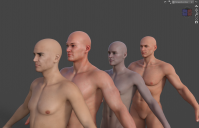How do you deal with differing skin settings for character of different vendors?
I heavily used the sales that just ended to buy many genesis 8 characters. Now I realize that the vendors seem to use differing settings for the skin which lead to very different tones. I don't mean just that one skin might be lighter or darker as another. There are characters with skins which look very alive, with a red tone in light, and there are others which look very fade. For example look at the attached screenshot: from left to right you see Henry, Elois, Bentley and Anderson. Henry is an older character so I suppose that the idea is to give him an elder look but Bentley (third from the left) looks completely out of order compared to the other.
I compared the settings for the skin for the face of Bentley with the skin of the face of Anderson: Bentley has a light turqiose color set for "SSS Reflectance Tint" (and "Scatter & Transmit" for the "Base color effect" setting) and some reddish for "Translucency color" where as Anderson, the guy on the very right, has no translucency color (just white and a map which is the lighter version of the base color) and for "Base color effect" here is "Scatter only" set which makes it impossible to set the "SSS Reflectance Tint". Maybe there are more differences but tweaking these settings seems to have the greatest impact on this issue already.
So my question is:
- is there a "this is the way to go" configuration for human skins to get them alive looking? Could it be that some vendors just went another way?
- When you combine these characters in a scene the differences become very obvious. Do you tweak the skin settings when you see this and if yes which configuration do you prefer and why?




Comments
- In general, the "alive looking" skin tones come from SSS (SubSurface Scattering). The toggle is Translucency Weight (and Thin Walled) with which you can configure the properties related to Transmission and Scattering on skin surfaces. The property values will vary depnding on the texture maps of Base Color and Translucency color. So that's why different vendors gave different settings in terms of SSS. Besides, temperature and color of lights also significantly influence SSS visual effects. Therefore, there's no absolute or only way to go for tweaking these properties.
- Yes, personally I do, in most of the cases. I go for tweaking Translucency, Transmitted and Scattering related slots with Iray Preview - On. You may refer to Parmy's skin tone tutorial (iray Uber shader) - https://youtu.be/eeWBh9cxOtc?si=E8Xn5Le62Cajt71T There's no big difference if you go for the settings with PBRSkin shader.
When I'm using skin shaders from different vendors that make the characters look like they're from, like, different universes, I do this:
1. Set up and light the scene, at least approximately.
2. Decide which character looks best in that context.
3. Apply that character's shaders to everyone. If the characters are all the same generation, this usually just means applying that character's material presets to everyone.
4. Plug everyone else's original maps back into their new shaders. Sometimes you'll have to finesse this, because a shader wants a specularity map instead of a roughness map, or what have you. Before I go to the trouble of converting a map, I'll try substituting some other map of the correct type that I have. If it doesn't make the two characters look like they're wearing the same skin, it's fine.
5. Massage as needed by, as crosswind says, tweaking translucency, transmitted and scattering colors. Sometimes base color, but it's usually the least relevant color.
5a. Save these new material presets, if I'm planning to use these characters together agaiin.
(It seems like the recently released One Click PBRSkin product basically does this for you, if you like the PBRSkin shader, which I do. I haven't tried it myself, but it might be something to look into.)
What this does is make the characters all look like they're made of the same substance and interacting with the same light. Human skin is very nuanced, much moreso than we can straightforwardly capture inside Iray. There's no single objectively correct material setting that's the right choice for every circumstance. What we can do, though, is create a believable world inside the frame of each individual render by making sure all the things in the frame agree with each other about how light works, how translucent skin is, and so on.